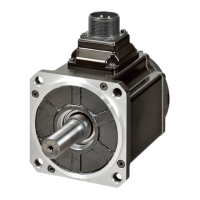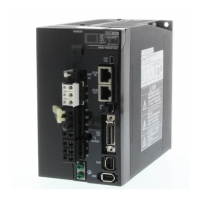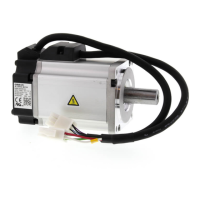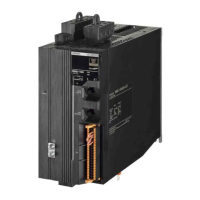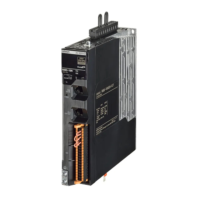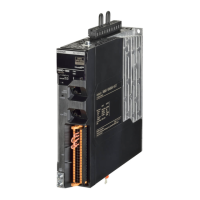
Do you have a question about the Omron R88M-1M Series and is the answer not in the manual?
| Series | R88M-1M |
|---|---|
| Type | AC Servo Motor |
| Rated Output | 100W to 750W |
| Encoder | Incremental or Absolute |
| Protection Class | IP65 |
| Rated Speed | 3000 rpm |
| Rated Torque | 0.32 to 2.4 Nm |
| Ambient Temperature | 0°C to 40°C (non-freezing) |
| Storage Temperature | -20 to +85°C (with no icing) |
| Ambient Humidity | 85% RH or less (non-condensing) |
Identifies personnel for whom the manual is intended, requiring electrical knowledge.
Contains information necessary for correct use of the Servo Drives and peripheral equipment.
Precautions on what to do and what not to do to ensure safe usage of the product.
Precautions on what to do and what not to do to ensure proper operation and performance.
Additional information to read as required to increase understanding or make operation easier.
Information on differences in specifications and functionality for Servo Drives with different unit versions and for different versions of the Sysmac Studio.
Details OMRON's warranty, limitations, and buyer's remedy for products.
States OMRON's liability limits, consequential damages, and the individual price of the product.
Addresses product conformity to standards and user's responsibility for determining suitability.
States OMRON's non-responsibility for user's programming of programmable products.
Contains disclaimers regarding performance data, changes in specifications, and errors.
Explains signal words (DANGER, WARNING, Caution) and their meaning for hazardous situations.
Explains the symbols used in the manual for operations and precautions.
Warnings and guidelines for selecting and using safety products within properly designed systems.
Qualified engineers must develop safety systems and install safety products in devices and equipment.
Safety products must conform to pertinent laws, regulations, and standards of the country of distribution.
Carefully read specifications and precautions for proper usage procedures.
Retain and supply Instruction Manual with devices and equipment when transferring.
General precautions for safe and correct usage of the product, including manual retention.
Explains signal words (DANGER, WARNING, Caution) and their meaning for hazardous situations.
Explains the symbols used in the manual for operations and precautions.
Warnings and guidelines for selecting and using safety products within properly designed systems.
Qualified engineers must develop safety systems and install safety products in devices and equipment.
Safety products must conform to pertinent laws, regulations, and standards of the country of distribution.
Carefully read specifications and precautions for proper usage procedures.
Retain and supply Instruction Manual with devices and equipment when transferring.
Guidelines for qualified engineers on developing safety systems and installing safety products.
Safety products must conform to pertinent laws, regulations, and standards of the country of distribution.
Carefully read specifications and precautions for proper usage procedures.
Retain and supply Instruction Manual with devices and equipment when transferring.
Precautions for installing Servo Drive, Servomotor, and peripheral equipment before wiring.
General precautions for safe installation and usage, covering location and environmental conditions.
Precautions regarding the mounting of the Servo Drive and Servomotor.
Precautions for correct and secure wiring of cables and connectors.
Precautions for safely transporting and unpacking the Servo Drive and Servomotor.
Precautions for careful handling of sharp parts and secure wiring of cables.
General precautions for safe installation and usage, covering location and environmental conditions.
Precautions for mounting the Servo Drive, including connector handling and robot cable usage.
Precautions for wiring, including tightening screws, using crimp terminals, and preventing fire.
Precautions for wiring, including tightening screws, using crimp terminals, and preventing fire.
Precautions for adjusting parameters, ensuring motor rigidity, and using emergency stop switches.
Precautions for checking operation after parameter setting and avoiding external drive sources.
Precautions for usage, including tightening screws, using stopping devices, and checking for earthquakes.
Precautions for maintenance, including data transfer, repair, and shaft checking.
Details on checking the Servo Drive model, rating, and lot number from the product nameplate.
Explains the model, rating, and lot number on the Servo Drive's nameplate.
Lists the accessories that come with the product, such as instruction manuals and warning labels.
Specifies which accessories are supplied and which must be prepared by the customer.
Details on checking the Servo Drive model, rating, and lot number from the product nameplate.
Explains the model, rating, and lot number on the Servo Drive's nameplate.
Lists the accessories that come with the product, such as instruction manuals and warning labels.
Details the model, rating, and serial number of the 1S-series Servomotor on the product nameplate.
Lists the accessories that come with the Servomotor, primarily an instruction manual.
Table showing decelerator models corresponding to servomotor rated output, without and with key and tap.
Table listing decelerator models for 3,000-r/min servomotors, including without key and with key and tap options.
Table detailing decelerator models for 1,500-r/min servomotors.
Table listing decelerator models for 2,000-r/min servomotors, including various power ratings.
Table detailing decelerator models for 1,500-r/min servomotors.
Details the correspondence between nameplate model numbers and Decelerator model numbers.
Details product models that come with an instruction manual and a connector for external regeneration resistor wiring.
Specifies product models that come with an instruction manual and two connectors to extend wiring.
Confirms that the product comes with two screws (M4×12) for mounting.
Details the correspondence between nameplate model numbers and Decelerator model numbers.
Indicates the location of the nameplate on the decelerator.
Explains the features of the Servo Drive and the name of each part.
Illustrates the system configuration for a 1S-series Servo Drive with Built-in EtherCAT Communications.
Describes the names and functions of Servo Drive parts, including connectors and indicators.
Illustrates the block diagram of a 1S-series Servo Drive with Built-in EtherCAT Communications.
Describes the standards to which the 1S-series Servo Drives, Servomotors, and Noise Filters conform.
Explains the use of unit versions for managing differences in supported functions due to product upgrades.
Explains the procedures to operate a system that incorporates 1S-series Servo Drives.
Shows the Servo system configuration with Controllers, Servo Drives, Servomotors, Decelerators, and other devices.
Describes how to read and understand the model numbers of Servo Drives, Servomotors, and Decelerators.
Lists the models of Servo Drives, Servomotors, Decelerators, cables, connectors, and peripheral devices in tables.
Provides the external dimensions and mounting dimensions of Servo Drives, Servomotors, Decelerators, and peripheral devices.
Provides general specifications, characteristics, connector specifications, and I/O circuits of Servo Drives.
Provides general specifications, characteristics, and installation conditions for 1S-series Servomotors.
Provides specifications for Decelerators.
Describes the specifications of the cables to connect between Servo Drives and Servomotors, and the connectors to be used.
Lists the specifications of External Regeneration Resistors and External Regeneration Resistance Units.
Describes the general specifications of the External Dynamic Brake Resistor.
Provides general specifications for Reactors.
Lists general specifications for Footprint-type Noise Filters.
Explains the conditions for installing Servo Drives, Servomotors, Decelerators, and noise filters.
Provides examples of connection with peripheral equipment and wiring of the main circuit and Servomotor.
Describes wiring conditions for 1S-series Servo Drives to conform to EMC Directives.
Explains how Servo Drives absorb regenerative energy using built-in capacitors and external resistors.
Provides precautions for adjusting Servo Drives with large load inertia and information on dynamic brakes.
Shows the machine accuracy (Total Indicator Reading) for Servomotor output shafts and mounting parts.
Explains the indicators and switches on the front of the Servo Drive and how to set the EtherCAT node address.
Explains the structure of the CAN application protocol over EtherCAT for 1S-series Servo Drives.
Describes the EtherCAT State Machine (ESM) controlled by the EtherCAT master.
Explains the use of Process Data Objects (PDOs) for real-time data transfer during cyclic communications.
Explains SDO communications used for setting objects and monitoring Servo Drive status.
Describes synchronization modes (Distributed Clock, Free-Run) and communications cycle.
Explains how emergency messages are sent to the master through SDO communications when errors occur.
Describes features provided by the Servo Drive when combined with Machine Automation Controllers and Sysmac Studio.
Explains how configuring a ring topology enables continuous communications even if a physical layer link is disconnected.
Explains the implemented control functions of the Servo Drive.
Provides block diagrams for TDF position control, velocity control, and torque control.
Explains the operation mode for cyclic synchronous position control.
Describes the operation mode for cyclic synchronous velocity control.
Explains the operation mode for cyclic synchronous torque control.
Details the path generation function for PTP positioning operation in Profile position mode.
Explains the path generation function for controlling velocity in Profile velocity mode.
Describes the homing operation using path generation function and homing methods.
Explains the settings required to connect the Servo Drive with an OMRON controller.
Explains the function inputs that can be allocated to the general-purpose inputs.
Explains the function outputs that can be allocated to the general-purpose outputs.
Explains how to prevent the motor from rotation outside the movement range using limit inputs.
Notifies that the present position exceeded the specified movement range and stops the Servomotor rotation.
Compensates the specified backlash compensation amount, travel distance, and present position.
Sets the output timing for the Brake Interlock Output (BKIR) signal that activates the holding brake.
Controls the position by multiplying the value obtained by multiplication of the position command input by the specified gear ratio.
Switches the torque limit according to the operation direction and input commands.
Performs auto acceleration and deceleration when step-type velocity commands are input.
Switches the position control gain, velocity control gain, and torque command filter.
Latches the actual position and time stamp at the rising edge of an external latch input signal or encoder’s phase-Z signal.
Outputs position information from the encoder in the form of two-phase pulses with 90° phase difference.
Enables stopping the Servomotor in events like drive prohibition, Servo OFF, or error occurrence.
Corrects the next target position based on the previous target position when target position is lost due to communications error.
Provides preliminary checks to determine the cause of a problem.
Explains how warning signals are output to check states like overload before errors occur.
Explains how Servo Drives output errors and display error numbers.
Provides information events other than errors that the user is notified of.
Provides guidance on identifying error causes and taking appropriate measures.
Details recommended maintenance times based on installation environment and application conditions.
Provides information on the expected lifetime of Servo Drive components based on operating conditions.
Lists the lifetimes for different parts of the Servomotor.
Explains the procedure for inspecting and replacing Servo Drives in a ring topology when a break occurs.
Describes the CiA 402 drive profile used to control the Servo Drive.
Explains the CoE objects implemented in 1S-series Servo Drives.
Provides a comprehensive list of objects used to control the Servo Drive.
Lists and describes error event codes that can be seen in Sysmac Studio.
Explains input and output response times for EtherCAT process data communications.
Describes the relationship between unit versions and Sysmac Studio versions, and added/changed functions.
